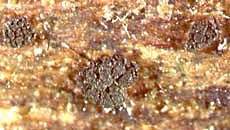|
Chaverri, P., Samuels, G.J., Stewart, E.L., and Umaña, L. 2001. Mycologia 93:758-763
Abstract: Hypocrea nigrovirens, a new species with a gliocladium-like anamorph, was collected on the Atlantic coast of Costa Rica. This species is recognized by dark green, almost black stroma, warts around the ostiolar opening, conspicuously thickened ascus tip and large conidia formed on gliocladium-like conidiophores.
 |
Visit the Trichoderma Identification Aid for an interactive key, images, descriptions, distributions, literature and nomenclature for the genus Trichoderma
|
Description of Hypocrea nigrovirens
Hypocrea virens Chaverri & Samuels, Mycologia 93(4):758-763, 2001.
Stromata solitaria vel gregaria, pulvinata, nigrovirentia, (0.3-) 0.4-0.7 (-1.0) mm, superficie tuberculata, ostiolo dum juvenia conspicuo. Perithecia dense gregaria, subglobosa. Asci cylindrici, (94.5-) 103.0-106.5 (-117.5) x (5.0-) 6.0-6.5 (-7.0) µm, apice incrassato, poro apicali praediti. Ascosporae bicellulares, ad septum disarticulatae; parte distali ellipsoideae, (5.5-) 6.0--6.5 (-7.0) x (5.0-) 5.5-6.0 µm, parte proximali cuneiformes (5.0-) 5.5-6.0 (-7.5) x (4.0-) 4.5-5.0 (-5.5) µm, olivaceae, conspicue verrucosae. Status anamorphosis Trichoderma, gliocladio similis. Conidia ellipsoidea, glabra, viridia, (4.0-) 6.0-6.5 (-9.0) x (3.5-) 4.5-5.0 (-6.0) µm.
Teleomorph: Stromata solitary and scattered, sometimes in pairs, pulvinate, dark green to almost black, KOH-, nearly circular in outline, (0.3-) 0.4-0.7 (-1.0) mm diam (n=11), at most only slightly constricted at base, surface rough, conspicuously tuberculate from perithecial apices, 5-11 (-15) perithecia per stroma (n=6), ostiolar openings visible when fresh, dark green nearly black, with warts. Stroma surface (16-) 18-22 (-25) µm thick (n=10), formed of angular cells, dark green, KOH-, (5.5-) 7.0-8.0 (-10.0) µm diam (n=12), densely compacted with walls 0.5-1.0 µm thick (n=10); cells composing the warts around the ostiolar opening dark green, KOH-, angular, 7.5-11.5 (-20.5) µm diam (n=28), walls 0.5-1.0 µm thick (n=10). Tissue immediately below the stromatal surface of compact, pseudoparenchymatous cells, colorless or slightly pigmented, KOH-. Internal tissue below perithecia pseudoparenchymatous, colorless or slightly pigmented, KOH-, cells (8.0-) 11.5-14.0 (-20.5) µm diam, walls 0.5-1.0 µm thick (n= 15). Perithecia closely spaced, subglobose, (179-) 189-253 (-255) µm high (n=4), (125-) 129-150 µm wide (n=4), ostiolar canal (56-) 57-78 (-81) µm (n=4) long. Asci cylindrical, (94.5-) 103.0-106.5 (-117.5) x (5.0-) 6.0-6.5 (-7.0) µm (n=25), with a thickened tip, with apical pore; part-ascospores uniseriate. Part-ascospores dimorphic, ellipsoidal, sometimes tending to be conical, especially at the ascus tip, distal part below the ascus tip ellipsoidal (5.5-) 6.0-6.5 (-7.0) x (5.0-) 5.5-6.0 µm, proximal part wedge-shaped (5.0-) 5.5-6.0 (-7.5) x (4.0-) 4.5-5.0 (-5.5) µm, dark olive green, conspicuously spinose.
Anamorph: Trichoderma sp.
Colonies on CMD colorless and odorless, aerial mycelium lacking. Optimum temperature for growth on CMD 28 C; growing 4 mm/d at 15 C, 11 mm/d at 20 C, 14 mm/d at 28 C and no growth at 35 C. Conidiophores scarce, scattered near the edges of the petri dish, nearly invisible, KOH-, arising from a stalk cell, multiseptate, thin walled, smooth, (123-) 124-171 (-173) x 8-15 (-16) µm, with one or two branches. Phialide branching penicillioid (gliocladium-like), 2-level verticillate sometimes biverticillate, with few phialides (8-12), producing a globose, watery green conidial mass; penicillus (0.02-) 0.04-0.05 (-0.09) mm wide. Phialides cylindrical, sometimes swollen in the middle, (9.0-) 13.5-15.5 (-20.5) µm long, (3.0-) 3.5-4.0 (-5.5) µm at the widest, (2.0-) 2.5-3.0 (-4.5) µm at the base, length/width ratio (2.5-) 3.5-4.0 (-6.0), never hooked or sinuous, axis of phialide (2.0-) 3.0-3.5 (-4.5) µm wide; collarette flared, slightly pigmented green; intercalary phialides common, metulae not common, cylindrical, (10.0-) 13.5-15.5 (-20.5) x 4.0-4.5 (-5.5) µm (n=15). Conidia broadly ellipsoidal, green, smooth to slightly spinulose, (4.0-) 6.0-6.5 (-9.0) x (3.5-) 4.5-5.0 (-6.0) µm, conidium length/width ratio 1.0-1.5. Chlamydospores not observed. Perithecia formed in culture within ca 10 d on CMD and PDA.
Habitat: On decorticated wood.
Known distribution: Atlantic coast of Costa Rica. Known only from the type location and collection.
Holotype: COSTA RICA. LIMON: Puerto Viejo, Refugio Nacional de Vida Silvestre Gandoca-Manzanillo, on decorticated wood, 8 Jul 1999. L. Umaña ( BPI, G.J.S. 99-64; ISOTYPE: INBio-Costa Rica).
|